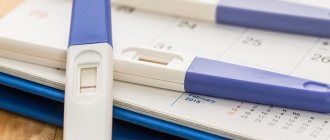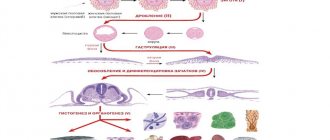A woman who wants to get pregnant is looking forward to the coveted positive test.
But how to determine pregnancy if the test does not show its presence? In this case, a graph with basal temperature readings can help, which helps give one hundred percent results if all the rules are followed. Basal temperature in early pregnancy is a fairly reliable and accurate way to determine conception. A pregnancy test is effective only 3-4 weeks after conception, and basal temperature shows it almost immediately.
Therefore, many representatives of the fair sex are interested in how to measure basal temperature to determine pregnancy. This is not easy to do, but the effectiveness of the indicators is worth the time it takes to create a special schedule.
In order to determine signs such as the onset of ovulation, a disorder or change at the hormonal level, as well as the time for conception, it is necessary to measure basal temperature - this is a low temperature indicator that is determined in the body at rest. Basal temperature is measured rectally, vaginally or orally.
BT - what is it and how to measure it?
Basal temperature, according to the definition existing in medicine, is the lowest temperature of the human body, which can only be recorded at the moment of rest. When we are active and mobile, our body's internal temperature always rises. And in women, the level of basic temperature also depends not only on activity, but also on the day of the cycle, because on different days the cyclical functioning of the female body is determined by completely different hormones.
It has long been noticed that during the period of ovulation, women experience a jump in basal temperature . This is the basis of the symptothermal method of fertility recognition, which allows women to see exactly when they have a mature egg leaving the follicle, which means the highest probability of conception.
- Menstruation
- Ovulation
- High probability of conception
Ovulation occurs 14 days before the start of the menstrual cycle (with a 28-day cycle - on the 14th day). Deviation from the average value occurs frequently, so the calculation is approximate.
Also, together with the calendar method, you can measure basal temperature, examine cervical mucus, use special tests or mini-microscopes, take tests for FSH, LH, estrogens and progesterone.
You can definitely determine the day of ovulation using folliculometry (ultrasound).
- Losos, Jonathan B.; Raven, Peter H.; Johnson, George B.; Singer, Susan R. Biology. New York: McGraw-Hill. pp. 1207-1209.
- Campbell NA, Reece JB, Urry LA ea Biology. 9th ed. - Benjamin Cummings, 2011. - p. 1263
- Tkachenko B. I., Brin V. B., Zakharov Yu. M., Nedospasov V. O., Pyatin V. F. Human physiology. Compendium / Ed. B. I. Tkachenko. - M.: GEOTAR-Media, 2009. - 496 p.
- https://ru.wikipedia.org/wiki/Ovulation
In the first half of a woman’s cycle, estrogen and FSH “rule” the body. The action of these hormones leads to the maturation of the follicle. A surge in LH the day before ovulation with a subsequent decrease in estrogen leads to a characteristic jump in core temperature. After ovulation, a corpus luteum is formed at the site of the follicle, producing progesterone. And under the influence of this hormone, the basal temperature rises and remains so for almost the entire second half of the cycle.
If pregnancy does not occur, the corpus luteum dies 10-12 days after its formation, the concentration of progesterone decreases, the basal temperature decreases and menstruation begins. If conception does occur, then after successful implantation of the embryo into the uterine wall, the production of the hormone hCG begins, which prevents the corpus luteum from ceasing to exist and function, progesterone remains high, and basal temperature does not decrease.
That is why the method of measuring BT is considered informative not only for determining ovulation, but also for the earliest diagnosis of pregnancy, as well as various gynecological pathologies and endocrine disorders.
To determine pregnancy using a basal temperature chart, it is very important to measure correctly. Any errors in this process will lead to incorrect readings of the true temperature and the woman will be misled. Therefore, when planning a conception, you need to learn important rules that will help you obtain accurate data. Let's label these rules.
You cannot measure your basal temperature under your arm. It is imperative to fix it in those parts of the body that are in close proximity to the cavities and communicate with them. This is the mouth, vagina, rectum. Having chosen one part of the body, always take measurements only in it, do not change the location of the thermometer.
Choose a good thermometer that works properly . Better - mercury, since mercury devices are more accurate than electronic ones. To take measurements in the oral cavity, a special thermometer is required. You can use a very ordinary thermometer in the rectum and vagina.
You need to measure BT in the morning at the same time every day. In the evening and during the day it is always elevated because we are active. And in the morning, after waking up, for some time the body still adapts to wakefulness and provides the thermometer with the most accurate readings of the temperature of the internal organs.
Don't make any movements, don't get out of bed. When you wake up, immediately begin measuring while lying at rest. In the evening, place the thermometer at arm's length and shake it off in advance.
The thermometer is inserted at 2-3 centimeters for 5-7 minutes.
The best time for taking measurements is considered to be from 5 to 7 am , but take into account your personal daily routine, because before the measurement, a woman should spend at least 6 hours sleeping, without getting up anywhere.
An increase in temperature can be affected by severe stress, a cold or viral disease, any inflammation, fatigue, travel, sexual intercourse that took place the night before, or alcohol consumed the day before. Under such circumstances, BT inevitably rises, so a woman may misinterpret her chart at the end of the cycle.
What is this method?
Basal temperature is the internal temperature of the human body. It is measured using a thermometer in the mouth, female genital organs or anus. The measurement should be done early in the morning, as soon as the woman wakes up. In this case, place a thermometer by the bed so that it is easy to reach.
To monitor the cycle and plan pregnancy, to determine it in a timely manner, it is necessary to measure the temperature daily, from the first day of menstruation, and record the result in a chart . The most informative way to measure temperature is through the rectum. For this purpose, a regular mercury thermometer is optimal, as it gives the most accurate results.
Early in the morning, after waking up, while the body is in a relaxed state after sleep, you need to insert a thermometer and wait 5-7 minutes . The result obtained is recorded in a notebook for keeping a chart, or saved in a mobile application.
“Pregnant schedule” – what does it look like?
Of course, the BT chart will only allow you to assume a possible pregnancy, but will not at all be able to accurately answer the question of whether conception has taken place or not. Although sometimes women planning pregnancy are very happy with such a hint. Take a close look at the cycle chart. To talk about the likelihood of pregnancy, it is important to see the day of ovulation on it to be sure that the release of the egg, as a prerequisite for conception, has taken place.
Most often, this day falls in the middle of the cycle; before it there is a decrease in temperature, and then it immediately rises. This “peak” visually divides your cycle into two phases and looks like the beak of a bird with outstretched wings. Before the “beak” the temperature was in the range of 36.2-36.9 degrees, on the day of ovulation - above 37 degrees.
The second half of the cycle takes place at elevated temperatures, but this is not a sign of pregnancy, but just a sure sign of the action of progesterone. It is produced in all women, regardless of whether conception has occurred or not. During the first week after ovulation, on average, your temperature, both during and without pregnancy, will be 0.4-0.6 degrees higher than in the first phase.
7-9 days after ovulation, implantation of the embryo occurs, if conception has occurred. The physiological and biological meaning of what is happening is the attachment of the fertilized egg to the inner layer of the uterus - the endometrium. On the day of implantation, a fairly common curious phenomenon is often observed - an implantation drop in basal temperature. It may drop slightly and rise again the next day. But such a reduction is not at all necessary. This depends on the woman’s personal level of progesterone in her blood.
If implantation is successful, under the influence of hCG the corpus luteum does not regress, but continues to regularly supply the female body with shock doses of progesterone, so the basal temperature remains high. The decrease 2-3 days before menstruation, which is observed by non-pregnant women in the phase of regression of the corpus luteum, will not be observed in a pregnant woman - all days before the delay of menstruation, BT will remain elevated (above 37 degrees).
It is this sign that should tell an attentive woman that an “interesting situation” is very likely.
How to make a schedule and what is it for?
A schedule in which a woman will record the data obtained during the procedure can be drawn up independently or printed from the Internet. There are many options for such tables on the Internet. You can see how they look in the photo. In this case, indicators such as the length of the menstrual cycle and data on the woman’s health status (illness, insomnia, stress, etc.) should be taken into account.
Indicators need to be marked with a dot every day, and then connected with one line. During the onset of conception, fluctuations on the graph may have their own characteristics:
- On the day of fertilization, the normal temperature will be 36.3-36.7°C.
- If you have ever determined pregnancy using this method, you should know that in the next 24 hours there is an increase in BT, which is approximately 0.1 ° C per day. This increase is observed within several days.
- On the day of implantation of the embryo into the uterine wall, a slight drop in numbers is observed. This is a completely normal phenomenon and there is no danger in it.
- After the implantation of the fertilized egg, the thermometer readings begin to rise smoothly again. Now they can reach 36.6-37°C.
- Reviews from girls who regularly measure BT indicate that in the next 24 hours the temperature fluctuates between 31.3-36.6°C. It is important to ensure that these numbers do not drop lower than they were at the time of ovulation. Since a frozen pregnancy is possible, this sign is very important for the expectant mother.
In addition to numbers, it is also recommended to note in the chart such circumstances as a girl’s cold, stress, overeating, poor sleep, etc.
This is due to the fact that these circumstances can affect basal temperature indicators.
Other chart options - reasons
If in the second half of your cycle thermometry shows an increase in BT to 38 degrees or higher, do not rush to rejoice, because. this does not mean, alas, about pregnancy. This means that a woman has a serious and severe inflammatory process in her body, and therefore she needs to see a doctor as soon as possible for examination. Most often, this temperature accompanies gynecological problems of an inflammatory and infectious nature.
Therefore, pay attention to discharge and pain. If the discharge is atypical, there is pain, or your health leaves much to be desired, you need to go to the doctor. A sharp jump in temperature to 38 degrees 6-8 days after ovulation may indicate an ectopic pregnancy.
Reduced thermometry readings in the second half of the cycle (36.5 - 36.9 degrees) indicate that the corpus luteum produces insufficient amounts of progesterone. In this case, even a pregnancy that has begun can be abruptly terminated at any time, since progesterone deficiency threatens miscarriage or frozen pregnancy at a very early stage. In addition, you should definitely consult your doctor.
In most cases, the situation can be corrected by starting to take progesterone medications as prescribed by the doctor.
Based on the results of the measurements, the woman could get a graph in which there is an increase in temperature in the second half of the cycle, but very insignificant - by 0.2-0.3 degrees, no more. In this case, it is worth suspecting endocrine disorders, often age-related. Indeed, after 30 years, the production of sex hormones significantly decreases. During such cycles it is difficult to conceive a baby, and if this is possible, then pregnancy is often accompanied by a threat in the very early stages.
A monotonous graph, in which it is sometimes impossible to clearly distinguish changes in BBT up or down, indicates an anovulatory cycle. There was no ovulation, and therefore you should not expect pregnancy - in the absence of a mature egg, conception is impossible. A chaotic graph with large peaks and valleys, a “royal” sweep of the curve indicates that gross errors were made during the measurement, so the graph itself does not reflect reality. And also such graphs are a sign of severe hormonal disorders, most often with them pregnancy is not possible.
A graph with a high temperature in the first half of the cycle does not even require further analysis of the increase or decrease, because it indicates an initial hormonal imbalance during the period of follicle maturation. Such schedules do not promise normal ovulation; usually, cycles when the rectal or vaginal temperature after menstruation is above 37 degrees are anovulatory, in which conception is impossible.
How to correctly determine low basal temperature?
To accurately determine whether your BBT is low or normal in phase 2, you need to compare the average temperature values before and after ovulation.
This is done as follows: all indicators of one phase are summed up and divided by the number of days in the same phase . For example, there is this graph:
Basal temperature without pregnancy on the BT chart
The average BT in phase I is:
(indicators for each day of phase 1)/15=36.5°
The average BT in phase II is:
(indicators for each day 2 phases)/10=36.9°
36.9-36.5=0.4 - the normal temperature difference is in the range of 0.3-0.5 (sometimes more). This means that this graph is absolutely normal.
If the difference is less than 0.3 degrees, it indicates an imbalance of hormones - this can prevent pregnancy. To establish the cause, you need to consult a doctor and take a hormone test. Here is a graph with a small temperature difference:
A small temperature difference between phases of less than 0.3 indicates problems with hormones on the BT chart
Advice(!) In most cases, BT in the second phase (before and after the delay) is considered low if it is only 0.29 degrees or less higher than the values before ovulation. For example, before the release of the egg, the average basal temperature is 36.4, after ovulation - 36.65 - this is a low BT in the second phase. Or, before ovulation 36.6, after - 36.8. In both cases, a doctor's consultation is required to consider prescribing hormonal support.
If a woman has 36.5 in the follicular phase, and after - 36.85, then the temperature difference of 0.35 ° is normal and this is not considered low BT in the second phase, even with a successful pregnancy !
Here is an example of a normal pregnant graph with a temperature of up to 37 and an acceptable phase difference:
Pregnant BT chart with a small difference between phases of 0.32 degrees
This is interesting(!) There are also abnormal graphs, far from the standard, but also pregnant women with a small temperature difference. Most likely, the reason is external factors that distort the indicators, or an individual hormonal feature:
Unusual Pregnant BT chart with small temperature difference
The given example is rather an exception to the rule. Most pregnancy charts have a temperature difference of 0.3 degrees or more.
Rectal temperature during pregnancy
Rectal temperature, first of all, becomes one of the most effective ways to determine the onset of pregnancy. Sometimes tests are wrong, and discharge occurs even after fertilization, which can mislead a woman about a successful pregnancy. But the rectal temperature will not deceive - its increased readings for three days in the absence of menstruation categorically indicate that fertilization has occurred.
Rectal temperature is measured in the rectum. And in the first 20 weeks of pregnancy, its indicator will be about 37 degrees and slightly higher. This situation is explained by the fact that in the first weeks of pregnancy, the processes occurring in a woman’s body regulate the hormones of the second half of the menstrual cycle.
Measuring basal body temperature for the purpose of contraception
The method of contraception using BT measurement is very simple. As is known, a woman can become pregnant on the day the egg leaves the ovary, that is, during ovulation, and within two days after it. If you exclude sexual intercourse in this phase, the conception of a child will not occur.
Does this method protect 100%? This question cannot be answered positively, because various changes can occur throughout the cycle, for example, ovulation will occur earlier or later. We can say with confidence that the method in question can be used as an additional method of protection.
What should be the basal temperature during early pregnancy?
There are not too many methods for identifying an “interesting situation” from the first days of its onset. But I really want to know about it earlier! Representatives of the fair sex who dream of a small miracle need to know about such a phenomenon as basal temperature.
By observing this indicator, you can easily determine the day of egg maturation, as well as monitor the condition of the fetus. basal temperature fluctuates early pregnancy .
Norm of indicators in different periods
On menstrual days, the normal temperature is 36.7 - 36.9 degrees . By the time of ovulation, it begins to rise, reaching its peak - 37.2-37.4 degrees. After ovulation occurs, the temperature should begin to decrease - if conception has not occurred. This usually happens 7-8 days before the expected date of your period. In the days before menstruation, it drops to 36.8 -36.9 degrees. If conception has occurred, the temperature continues to remain at 37.1-37.4 degrees.
Basic definitions
BT is the value of the internal temperature of the female body at the moment of absolute rest, which is measured by inserting a special thermometer into the rectum. There are other ways to track basal temperature (orally or vaginally), but rectal measurement is considered the most accurate
Tracking basal temperature helps to obtain a lot of important information about a woman’s body:
- see the general picture of the condition of the internal genital organs;
- learn about diseases of the reproductive system and the body as a whole;
- monitor the development of the fetus in the womb.
BT directly depends on the hormonal background, the predominance of certain hormones in the blood. Measurement values vary depending on the stage of the menstrual cycle and the onset of conception. Before you can establish what basal temperature during pregnancy is normal for you personally, you need to learn how to determine it correctly. Moreover, the analysis must be carried out over more than one month.
What could an increase or decrease in BT indicate?
We found out that basal temperature is an important indicator with which you can judge whether the fetus is developing normally in the womb. If the numbers on the thermometer drop sharply or, conversely, rise, this should alert the expectant mother. What could such conditions be associated with?
Reasons for the increase
Many women measure BT throughout the first trimester, less often in the second, and this is the right decision. The fact is that during a healthy pregnancy, these indicators should remain unchanged or fluctuate slightly. If there is a strong increase, this may indicate the development of an inflammatory process in the body. Such examples are often found in gynecological practice. Of course, this is not an indication for termination of pregnancy, but this sign should not be discounted either.
How to measure BT: basic principles
In order to draw any conclusions from a thermometer, you must understand how to correctly obtain these results.
The main requirement when determining basal temperature: the procedure is carried out earlier in the day, after you open your eyes.
You need to take the measurement carefully, without straining, always in a supine position, subject to absolute peace and quiet.
We emphasize that basal temperature is not measured during the day! Correct data can be extracted only in a motionless body position after a full night's sleep (at least 6 hours).
If you ignore the recommendations, you may get inaccurate numbers.
There is no need for repeated samples at different times, because... the indicator may change every 1-2 hours. Therefore, basal temperature in the evening, at lunchtime or in the morning after getting up and doing physical activity has no value.
To extract genuine information, adhere to the following principles:
- to start measuring your basal temperature with the onset of your period, and do not miss a single day. It is possible, of course, to start from the middle of the cycle, but if your goal is to get the highest accuracy of the result, then it is better to do this from the 1st day of your period.
- Data recording must always be done strictly at the same time in the morning without changes. Moreover, it is important to use the same thermometer to avoid inaccuracies. The duration of the process is 5-7 minutes if it is a mercury device, 60 seconds if it is electronic. Moreover, this time must remain unchanged every time.
- If for some reason you need to get up earlier (for example, to go to the toilet), then still conduct an observation, but always before you get out of bed.
- It is not advisable to record basal temperature during pregnancy during treatment with sedatives and hormone-containing medications. If samples are taken to determine the moment of ovulation, then there is no point in doing them if you are taking birth control pills or have too much alcohol.
- If measurements are taken to identify the day of ovulation, then data collection must be continued for up to 3 months.
- The data is recorded immediately after removing the thermometer, and if it is mercury, then you need to hold it by the other end so as not to confuse the results with the warmth of your hand.
- To monitor the basal temperature chart during pregnancy, it is advisable to record the obtained numbers daily in a personal diary. It is important to note your condition these days (stressful situation, cold, pain, etc.).
Factors that may distort BT indicators
An elevated basal temperature during a delay does not necessarily indicate pregnancy. Here are the factors that can affect BT towards its increase:
- local inflammation (infection in the measurement area: hemorrhoids, stomatitis, thrush, etc.);
- ARVI;
- poor sleep, getting out of bed half an hour or two hours before measurement;
- measurements later than standard time (permissible deviation ± 30 minutes);
- using a different thermometer that day;
- change in the place of measurement (they always measured it in the mouth and suddenly switched to the rectal method).
Note(!) It makes no sense to take measurements during the day or evening, or in the morning after any activity. BT increases instantly and becomes non-indicative (for a more detailed study of the factors influencing BT, see this material).
If all of the above factors are excluded in your case, then BT on the first day of the delay is naturally increased . Well, it's time to take an ultra-sensitive pregnancy test (10 mIU/ml). By the way, he is able to detect early pregnancy even before the delay!
What is the normal basal temperature during pregnancy?
Before we move on to studying the results of the thermometer, let's figure out how BT generally behaves in different periods of the life cycle and what this says about the state of its body.
Phases of the menstrual cycle (MC)
The MC of a reproductively healthy woman can be divided into 2 stages:
- until the moment of ovulation;
- after ovulation occurs.
In the first stage of the cycle, the thermometer will give values less than in the second (normal values are between 36.6 and 37 degrees Celsius). After the release of a mature egg from the ovary, the content of the female hormone progesterone in the blood increases and, as a result, BT increases by 0.3-0.4 degrees.
If an increase occurs, then safely assume that ovulation has occurred. But, as mentioned above, it is advisable to track indicators to determine a favorable day for at least 3 months to be sure. This way, you will know exactly which day the chances are highest.
But an increase in basal temperature from the middle of the cycle and its stable presence at a value of more than 37 ° C until its end may mean the onset of an “interesting situation”.
Moreover, the probability of successful conception and implantation of the embryo in the endometrium in this case is quite high.
It is worth noting that it is not the indicators themselves that are important in tracking basal temperature, because they may vary among different representatives of the fairer sex, depending on the characteristics of the body.
It is necessary to pay attention to the difference between the measurement results at different stages of the menstrual cycle.
Advice from gynecologists
Keeping a schedule for such measurements is recommended for patients of childbearing age. Why:
- Allows you to monitor your health.
- If the value is high in the second phase of the menstrual cycle, then conception has occurred.
During the cycle, a woman’s body and her reproductive system changes significantly. When ovulation occurs, the indicators increase sharply, and during menstruation they decrease. Due to such differences, it is possible to draw conclusions, determine the state of reproductive functions, the patient’s readiness to conceive or the presence of it. Constantly recording results helps with this.
Normal basal temperature during pregnancy
If you are convinced that the fertilized egg is fixed using a test or after being examined by a doctor, then you should not stop monitoring. On the contrary, it is very important to continue daily monitoring, since basal temperature during pregnancy is an essential diagnostic criterion. Thanks to the collected information, you can find out about the occurrence of various inflammations and pathologies, assess the risk of miscarriage and immediately begin treatment.
Possible thermometer readings:
- The normal basal temperature during conception and successful implantation of the fetus in the womb ranges from 37.1-37.3. It reaches this value on the day of ovulation and remains at this point during the first few months of pregnancy. Note that each female body may have its own norm and minor deviations from the generally accepted value are not terrible. But a difference of 0.7-1 degrees (no matter in which direction) indicates a possible pathology.
- If BT reaches 38°C and continues to rise, then this is an alarm bell for the woman, indicating ectopic attachment of the fertilized egg, or fetal freezing. In this case, you need to urgently, without delaying until tomorrow, consult a doctor to eliminate the unpleasant possibility or begin immediate treatment.
- A decrease of 0.1-0.4 degrees is also possible. A low basal temperature may simply be due to the expectant mother being overworked, stressful situations, or changing weather conditions. But this sometimes also indicates the presence of some kind of failure. There is no need to panic, but you still need to go to your gynecologist.
- A decrease in BT to 36.7 or below often entails the risk of the baby’s death and the possibility of miscarriage. If you notice such dynamics in yourself, and you do not have a cold or have been exposed to stressful situations, immediately go to the hospital.
This parameter is fixed at a constant level during the first 16 weeks, then begins to gradually decrease. Those. if you find that you have a low basal temperature at 4-5 months, then this is not a reason to worry, but an absolutely normal phenomenon. With the onset of the 20th week, it is possible to stop your observations, because... there is no longer any special need for this.
So, we figured out the concept of basal temperature, learned how to properly monitor it, found out when it rises or falls. What are the reasons for this and what to do in this situation.
As a conclusion, I would like to note once again that keeping a chart of basal temperature during pregnancy is not only necessary, but also very important.
With its help, you can identify both the fact of conception and the peculiarities of its course, eliminate violations and begin treatment in time if problems are identified.
However, the diagnosis is not made solely on the basis of your research. For this purpose, all kinds of tests, ultrasounds, and examinations by a doctor are prescribed. With a qualitative survey, concerns can be allayed.
But you should not neglect keeping a schedule, since these seemingly insignificant numbers can protect you from sad consequences , such as:
- miscarriage;
- ectopic embryo attachment;
- the presence of inflammation in the genital organs;
- infectious diseases that threaten the health of a pregnant woman.
By regularly noting the thermometer readings, you can always notice deviations and consult a doctor in a timely manner.
Delay and low basal temperature
By low BT I mean numbers that are below your normal second phase, closer to the level of the first phase. There are 3 types of charts possible:
- You had a vaguely expressed difference throughout this cycle (second graph). Perhaps there was no ovulation at all, so we cannot talk about a delay. Either the ovaries decided to “rest” or there was a hormonal imbalance - there can be many reasons for delaying menstruation. In this case, I recommend that you consult a doctor as planned.
- The graph showed a good temperature difference, but then BT decreased and remains low (the very first graph). In this case, you should expect your period in the next 2-3 days. If after 3 days menstruation still does not begin, then just in case, you can take a home pregnancy test and make an appointment with a doctor.
- The basal curve was high in the second phase, but then fell sharply for one day and then rose again . Such cases sometimes occur during normal pregnancy - you can do a test!
BT drop during a 1-day delay on the Pregnant basal temperature chart









